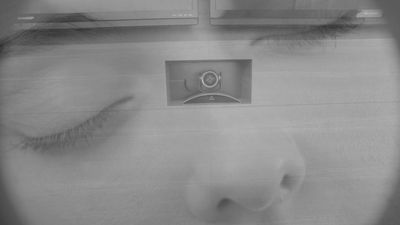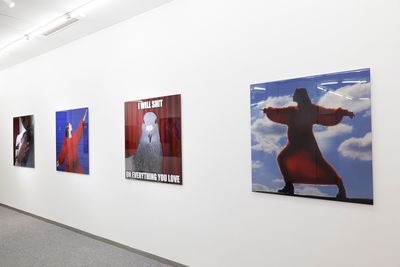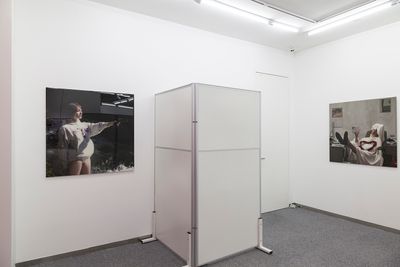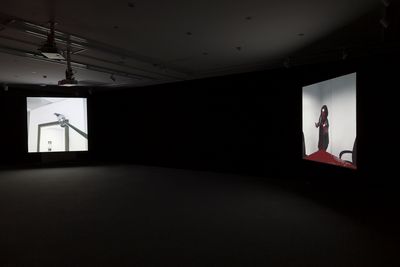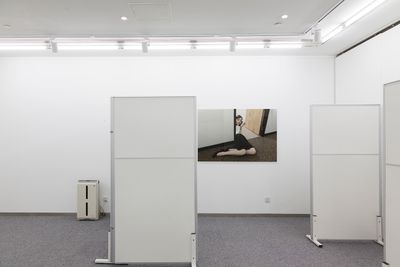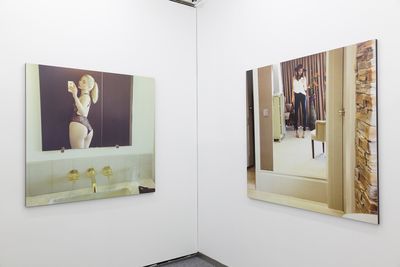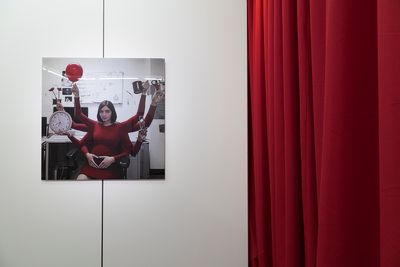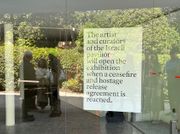Amalia Ulman
Amalia Ulman, Privilege 1/14/2016 (2016). Fuji Photo print on aluminium dibond under clear composite. 100 x 150 cm. Courtesy the artist.
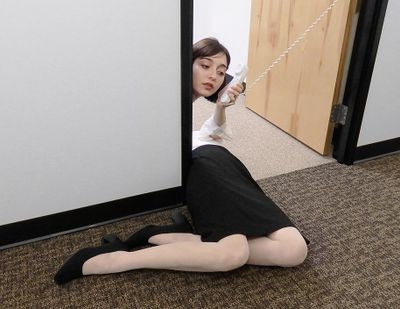
Amalia Ulman, Privilege 1/14/2016 (2016). Fuji Photo print on aluminium dibond under clear composite. 100 x 150 cm. Courtesy the artist.
Amalia Ulman's recent solo exhibition in China, Privilege, was staged at the KWM artcenter in Beijing (22 March–19 May 2018). This comprehensive show took full advantage of the office context and the partition structures of the space, which is located on the second floor of the WFC centre in Beijing's CBD area (the centre is supported by the law firm King & Wood Mallesons). It included a selection of videos and photographs from the artist's 'Excellences and Perfections' (2014) and 'Privilege' (2015–2018) series—both time-based performances that were staged on the artist's Instagram account. In 'Excellences and Perfections', Ulman took advantage of Instagram's image-centric format to develop an entirely fictitious persona. After revealing that it had been a performance, Ulman began 'Privilege', which took the office environment as the backdrop to a new narrative with a pregnant, theatrical version of the artist at its centre.1
During her stay in China, Ulman was also invited by Chinese artist Chen Zhou to collaborate on the latter's short film sponsored by Nowness, SIGhostNAL (2018). Also in an office setting, Ulman plays the role of a female office worker in a story that unfolds as a dreamy, stream of consciousness. In this conversation, Ulman talks about her collaboration with Chen Zhou, her impression of China in relation to her own geographical and generational background, and the origins of her performative practice online.
LBYou were recently invited by Chinese artist Chen Zhou to star in his short film, SIGhostNAL (2018). What was the experience like?
AUHe directed me, and it was the first time that I did that. Before the shooting I was a little bit nervous. I was introduced to Chen Zhou, but I did not know who he was. I have worked on projects of a similar nature with magazines before, and sometimes it works out well but sometimes they put you with somebody who has nothing to do with your work. A lot of people don't really understand my work, or only do so superficially; so they assign me to somebody who is only connected to me on a very superficial level. I don't feel very comfortable with those projects.
But there was something special about Chen Zhou's proposal. Before the shooting, I was only shown a piece of text. There was something that I liked about it. It was this story about a fish, with allusions to Buddhism. I understand that Chen is a very religious man, and I am a very religious person too. So, I thought it could be either really tacky, or, we could be on the same page. So I risked it, and said let's do this. It was a big crew and I was positively surprised at how professional it all was. We shot for a whole day. I loved working with him, because he is talented and focused; he knows what he wants. It was a pleasure to do that. I enjoy performing, but it was also great to have someone directing me. I always work by myself and it's stressful. In this case, I was only following his rules, which I found relaxing.
What was the set like?
It was in a conference room. My appearance was in a dream-like situation, somehow surreal, but in the context of an office building. From working with him I suspected that we were similar but talking to him afterwards made me realise that our brains fit like pieces in a puzzle. It was exciting, because it does not happen often that two people from vastly different backgrounds are connected at the core in so many ways.
LBSpeaking of a religiosity—you were saying you are, in a way, religious, just like Chen Zhou?
AURaised in a Catholic country, I was initially an atheist. I was not subscribing to Catholicism. In Spain, Catholicism is maybe like Buddhism in China, it is more part of the culture, but it is not like everybody's militant about it. People don't think about it too much. It's more about the celebrations, food and traditions that go with it. It's not a doctrine. As a teenager and as a leftist raised in Spain, you have to also be an atheist. There is no question about it. Religion is bad, end of story.
My best friend in Spain is very sensitive, almost mystic. We started doing yoga together at a community centre in our neighbourhood in Gijón. The teachers were really good; we meditated a lot and were taught properly. For the first time in our life we were praying, and meditating. It changed both of us. My friend is now a yoga instructor, very devoted to it. In my case, I allowed myself to have intuition that was castrated before—castrated by these atheist, scientific, political, masculine ideals that ruled where I studied Fine Art. Now I allow myself to feel. I was in a terrible accident in 2013 when I almost died and got to be in that space before God said, 'Let there be light'. That experience made me question not God, but perception.
That feeling of emptiness also achieved when you meditate—that moment is very real. I became more and more interested in it, and allowed myself to indulge in it. I experimented, went to meditation retreats. California is known as a hub of cults, and has this history of new religions. The desert surrounding L.A. creates a loneliness that makes people ask themselves a lot of questions. My dream was to go back to university to do religious studies. I see religion as different fictional narratives and interpretations of the same true feeling—systems that deeply influence cultures across the world.
LBHow are the performative lectures that you frequently stage connected to your other practices?
AUThe performative lecture I did at the Central Academy of Fine Arts was called AGENDA (24 March 2018), and it was about the year-long online performance, 'Privilege'. I started making video essays a while ago, using PowerPoint, voice-over techniques, sound effects, animated GIFs and so on. After finishing 'Excellence and Perfections', when I gave talks about it, I used a similar format.
Generally speaking, I think artists' talks are often boring; English is not my first language, so I also needed a script. So I decided to make art out of the format of the lecture. It started more on a fundamental level, and later developed into a performative practice that is also more abstract. So, they are not really lectures that talk directly about the work, but more about the feeling 'behind the scenes' while creating the artworks. Which, in the case of AGENDA, had to do a lot with what was happening in America with the elections, what was happening inside my body while taking oestrogen, and what was happening at the office, which was my studio, during 'Privilege'.
LBHave you done this with translation before?
AUI did in Argentina. This time, in Beijing, the PowerPoint had already been translated, and during the lecture there was also a translation. I get invited to many universities, the students there really love the format because it's fun, exciting, and concise; not long and boring. I like being playful with the format. I used to be a nerdy librarian when I was younger, and I approach academia, stationary, books and conference rooms with all the love in the world.
LBYou have been visiting Asia rather frequently in recent years. What do you think about the landscape here?
AUPreviously, I had only spent two days in Beijing, on my way to Pyongyang. Before that, I came to Hong Kong once, for a brand collaboration. It was my first time coming to China and I fell in love instantly. I came to Shanghai last September for the RAM HIGHLIGHT 2017: DISPLACE exhibition at the Rockbund Art Museum (29 September–4 October 2017) and Shanghai became my favourite city in the world. I like Art Deco aesthetics and that combined with Chinese culture is like a dream. I am also fascinated by the history of foreign prostitutes in 1920s Shanghai. I'd like to come back for Art Basel Hong Kong next year—or sooner. The only thing that keeps me happy right now is knowing that at some point in the future I will return to China. I am taking Mandarin lessons as well.
I started making works about objects manufactured in China for one of my first video essays, Buyer, Walker, Rover (2012). In that work I was mapping the very same Chinese imports that I had seen in Los Angeles, London, Berlin, New York, Greece, and Gijón. As if these objects were the only point of connection between the small provincial town where I'm from and the world—not necessarily out of an interest in China, but because poor areas in Europe have been deeply influenced by Chinese aesthetics. With local stores closed down, the only available items are Chinese.
Years ago, you could go to a Spanish store and buy a cup that was more expensive but was of a certain quality—with tradition and craftsmanship behind it and whatnot. Or, you could go to the Chinese store and get a cheap one. But after the economic crisis, almost all traditional Spanish stores were forced to close down. Nowadays, the working class can only acquire Chinese objects. So, coming to China, things are strangely familiar to me, because my city started to look like this. My relationship with China started with a long-distance conversation through objects and my personal experience of these. And now that I try to visit often and am learning the language, my love just deepens.
I assume it is also generational—you are not like the previous generation of European artists, who would come to China and start identifying a local social problem, amplify it, judge it, and criticise it through their practice.
Definitely. It's because I belong to this younger generation, and it also has something to do with the fact that I grew up as an immigrant. A lot of Chinese artists of my generation that I have met have very similar immigrant experiences as well. They either grew up as immigrants, or went to London or elsewhere to study. So, we all share the expectations from our parents who never went to college, and the disappointments of going to elite international schools which maybe weren't as good as western-centric media made us believe.
LBAnd you might think also that the aesthetic dimension of the Chinese-speaking world is just as important as the social dimension.
AUYes of course. I am an artist, I look at things—I value the visual aspect. Also, maybe because I am a punk, I am interested in looking at things that people don't want to look at. For example, Spain has always had a very racist and negative view of Chinese business and culture. All of my artworks about Bob the Pigeon, who was a character in my last performance, 'Privilege', were an attempt at trying to transform something people dislike—or don't feel passionate about—into something they love. A big part of my work is about that: taking something bland that people can't even see anymore, putting it under a different light and looking at it from a different perspective. Growing up as an immigrant, my 'normal' wasn't other people's 'normal'. I always had an outsider's point of view.
I think my practice comes down to class differences. What things look like, what they mean, how people present themselves ... the importance of little details. That, for example, is a very important part of life in Argentina. I grew up hearing my parents talk about fashion and aesthetics. The Argentina of my parents' generation still tried to feel European despite being far away. Class was intimately related to objects, imported clothes, and electronics. As a result, people have a very fine eye for identifying counterfeit material and bootleg copies. 'Oh, those Nikes are made in Brazil, I know that because the sole is made from this material that is different to the ones that come from America.' The little details people constantly pay attention to are markers of class and social status—almost to the point of paranoia.
Thankfully, my generation has come to accept the fact that Argentina is indeed in Latin America. And though previous generations were just replicating whatever came from abroad, younger artists are making very interesting things. I think if my work's framed as an aestheticisation of the everyday, it might come from my upbringing as an Argentinian, hearing my parents complain about not getting the right pair of jeans.
LBSo if you were to be identified in the history of Argentinian contemporary art, would you say that you are enjoying the legacy of the newly built, newly localised identity?
AUYes. I think I am definitely part of a new generation that has come to terms with this. I think mine is probably the first generation that can travel long distance frequently. My parents have visited the US as tourists twice so far in their lives. It's not like going to college or living in different places a few months at a time. I think it's the same in China as well—a huge departure from your parents' life. You finally get to see and experience the places that you've always seen in movies, places that live in the collective imaginary. Once you are able to experience the reality of these cities, you realise how embellished your idea of them was and how you could easily go back to your country, make art there, set up businesses back home, and so on.
LBIn recent years, there has been a rise in young artists who have been educated abroad, who then come back to China and practice here. They have been rather harshly criticised for creating works that are not relevant to Chinese contemporary society.
AUYes, that happens to me as well. I was joking with the Spanish ambassador the other day, that people from Spain do not care about my work at all—never even talk about it, never give me any recognition. I was like 'hey, what's up with that, Mr. Ambassador?' I love Spain, I spent my life there. I go back whenever I can, and I constantly feel homesick, but Spain never cares.
LBYour works are apparently not about the specific geopolitical condition in Spain.
AUBut there are definitely a lot of references to my experience of growing up there. Even if you go abroad to study, your childhood, the neighbourhood, the TV you watched growing up—all that stuff is so ingrained in you. Going to college for three years is not going to change that. It's not going to erase that at all.
LBI want to start from another related subject: Instagrammable shows here in China. It's a huge trend. A successful show is essentially an Instagrammable show. It would be unfair to say you are the one who inspired this, but you are part of this selfie economy.
AUMy use of Instagram happened more or less by accident. I don't even use it the way influencers use it, I am not there all the time, I am not putting up stories. So, I think it's unfair to be called an Instagram artist.
I could only have done 'Privilege', by doing 'Excellence and Perfections' first. I needed to gather the attention through something that is visually pleasant, then do something weird. I see a big difference between indie culture in the nineties and the trends that are happening now. Nowadays, people like indie aesthetics, but they demand it to be of a mainstream status. It does not make sense, because that was the whole premise of being a punk or whatever. Your audience might always be small, but that does not mean you are bad.
I think people are paying too much attention to the popularity of an image, which is—as any serious journalist would know—just women looking hot in pictures. I think that is a weird way of measuring an artwork. That's the barometer of glossy magazines, which is fine, but it shouldn't be applied to everything else. It's a weird moment now that everyone is required to be popular.
The inception of 'Excellences & Perfections' was when I saw girls using social media, like Facebook profiles and Instagram, as mood boards, and these mood boards accessorised their real life. They showed that, 'I am into this kind of stuff, this handbag and these shoes.' I was fascinated. But it was also aspirational: the girls would not take selfies in their home, but would go to a hotel and dress up and do that. I saw how this behaviour online was affecting real life. How you would probably have a better chance of getting a decent job, or even being paid more as a sugar babe or a prostitute, if you had nice-looking photos taken in nice places. And so it goes back to representation and class, and how you present yourself.
I observed this before Instagram, on another social media platform called Fotolog (http://pooool.info/f-f/) where young people from Argentina posted their photos and you could tell by simply looking at the background of their portraits what their social status was. And this is from when people were still more earnest online; then after some time I saw a lot of photos being taken in nice hotels and restaurants. That's how 'Excellences and Perfections' came about. That work was mostly imitation. Because gathering a large online crowd was an important step. And it was about distancing my online persona from my real self.
In the second one, 'Privilege', I really wanted to be playful with the format and the form, and to question the real self. It was about playing a caricature of myself but exaggerating it at the same time. Wearing wigs that in fact looked like my hair. In the first performance I staged a boob job, in the second one a pregnancy, which also had to do with my insecurities and anxieties when I was creating the work. Pregnancy also added a durational aspect to the work, with a beginning and an end. I thought it was good to tie the whole project together with this durational aspect. But aesthetically, it all had to be different from 'Excellences & Perfections', so I used propaganda techniques, a very specific colour scheme, a selected series of objects and a sidekick. In this performance it's easier to see it's all fiction.
LBDo you think there are peers out there, practicing in a similar way?
AUI am sure there are people doing similar practices, but the people and things I pay attention to are not that. I didn't really look at anything else to get inspirations for the projects. I have been 'a girl online' since I was at least 16, so I am familiar with the whole thing, a girl plus a camera and the internet. Somebody would mention Cindy Sherman; I respect her as a great artist, but I did not look at her work for inspiration because it was not necessary. It was natural for me as it is for any other girl. Me with Cindy Sherman can be a very flat comparison: woman, photo.
LBIs there a statement embedded in your first solo exhibition here in China?
AUKWM artcenter tried to push a statement forward, which makes total sense, of course. I was very excited because, with this chance, I got to talk about my practice properly. The show was comprehensive, and I always try to be site-specific as much as I can, so I incorporated the red drapes and the office partitions in the show and tried to play with the space, which is in fact in an office building, just like the office where the performance 'Privilege' took place. Usually I have to transform the space into an office setup, but here the space is already set up as an office.
LBThe other problem with your practice is that an audience can almost look at everything online. So why go to an exhibition?
AUThat's also why I most often don't show prints or videos in my solo shows but do installations and am site-specific, because these spaces are where ruptures lie, and cannot really be documented online. That's what I did with my first show in New York, Stock Images of War (James Fuentes Gallery, 11 January–8 February 2018). It was a big, dark space draped in black, filled with large sculptures, a strong smell, loud music, and it was in the winter. That show inspired a lot of writings, for example, but was almost impossible to document with photos.
As an internet artist, I like to do shows that cannot be easily flattened for screens and have to be experienced in person. When I came out of college I was very disappointed with the trend of post-internet art. I remember seeing the shows, and everything there was made for the internet, for the photo. But in person, many exhibitions looked awful. I guess that was essential to the trend in fact. I remember seeing an installation by Joseph Beuys at the Pompidou, and I said to myself: I miss this. I want to do this kind of work, not just a photo.
This also goes back to my interest in religion and the spiritual: my body is still here. I like feeling things, smelling and hearing things. The world is more than a photo. It is a sensual place, not an act of looking constantly at a screen. So that's when I decided my installations would be real installations. Not to be documented and put on a blog, but for people to walk around and experience. I hope that even with your eyes closed, art can still be a life-changing experience. I grew up listening to the radio in bed before I went to sleep and am hyper-sensitive to smell and light. I want to make work accordingly. —[O]
—



